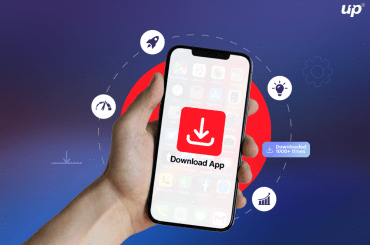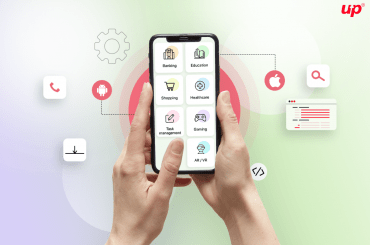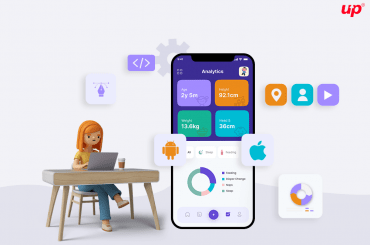About 1 billion smartphones and 179 billion mobile devices downloaded annually, software technology is one of the most creative and aggressively rising sectors. Google apps (Gmail, Maps, Search), social media (Facebook, Instagram, Twitter, Youtube), and game apps (Angry Birds, Temple Run) are currently dominating the mobile app market. Giants such as Walmart, Bank of America and Amazon use smartphone branding apps, improving customer loyalty, targeted messaging, etc. Small and medium-sized mobile app development companies in UAE follow the internet phenomenon, too. Ultimately, more than just a mobile-friendly app. The creation of mobile applications is driven by technological advancements which allow businesses to have a vision for the next few years. Below are some of the patterns which will decide the future of mobile apps.
 Wearable Devices
Wearable Devices

101.9 million Connected devices were delivered in 2016, up 29 percent from the 79 million units shipped in 2015, according to IDC. Smart wearables such as the Apple Watch and the Hololens from Microsoft display an imminent shift in software and the transition from simplistic to advanced wearables. That opens up new markets for retailers, creators of software and suppliers of accessories. The mobile will become the hub of a personal-area network composed of connected accessories such as on-body wellness monitors, smart jewelry, smartwatches, viewing apps (such as Google Glass) and a range of monitors installed in clothes and shoes.
Also Read: Why Mobile Apps are Better than Mobile Websites?
Motion and Location Sensing
Most mobile phones have location sensor capabilities that provide different location data granularities using multiple positioning methods. Knowing the location within a few meters of a person is useful for providing highly specific contextual knowledge and services. Motion sensing technologies are used in security, anti-theft, power-saving and game technologies. In Geotagging, Gaming, Car Navigation, and Gym applications, location sensing is helpful. Apps currently use specific indoor positions to use technology such as Wi-Fi, graphics, ultrasonic beacons and geomagnetic. This will also become relevant in the longer-term developments such as smart lighting.
M-Commerce

Mobile App Development Companies agree that the upward rise in smartphone sales will continue over the next four years as more and more customers are moving to m-commerce. Apple Pay and Google Wallet’s increasing success would allow transactions using cell phones rather than debit or credit cards. This would allow developers to create a smartphone application that can handle purchases without the need for actual debit/credit cards or cash. Coupled with wearables that can handle m-commerce payments, this will take on a different aspect. Wearables will also play a crucial role in the future of electronic purchases and consumer engagement, including data analysis and predictive analytics.
Application Performance Management (APM)
Two causes create efficiency bottlenecks in software development, i.e. mobile platform variety and mobile network not-deterministic. Yet the training and quality assurance strengthened with mobile metrics and reporting systems commonly known as Application Quality Management (APM). APM provides insight into app usage, provides information about the platforms and operating systems are being implemented, and tracks user activity to assess the app apps are being actively used. With the technology environment and business infrastructures shifting to the cloud, APM technologies face growing challenges to deliver practical performance gains across virtual perimeter systems.
Internet of Things

Gartner estimates that by 2020 there will be 26 billion connected devices like several hundred digital items including LED light bulbs, toys, home appliances, athletic equipment, medical devices, and controllable power sockets, etc. Such domestic smart devices can be part of the Internet of Things and connect on a smartphone or tablet with an App. Smartphones and tablets can serve as remote controllers, view and evaluate the content, connect with social networks to track “stuff” that can tweet or upload, pay for subscription services, order new consumables and upgrade the firmware of items.
Enterprise Mobile Management
Enterprise mobile management (EMM) is a group of individuals, processes, and technology using mobile computing for streamlining businesses. The key dimensions of EMM are security, program management, and financial management. It also includes mobile device management, mobile program management, data packaging and containerization, and some integration and exchange of enterprise file components. These solutions can evolve, broaden in reach and finally tackle a wide variety of mobile management needs for all common handset, tablet and PC operating systems. EMM thus reflects the potential growth and integration of various mobile management, defense, and technology support.
Innovative Mobile User Experience Design

For a sound user experience, it is essential to view data and content effectively on your mobile user interface. Popular mobile device firms, such as Houzz, Instagram, Pinterest, and Wunderlist, have created new themes that represent streamlined architectures and immersive interfaces. Even programmers create apps that can deal with smartphone problems, such as limited user focus and disruption. Apps can take advantage of technology with innovative features such as dynamic interface levels, rotating design patterns, cards, and information manipulation. Such apps create an “augmented reality” by encouraging users to engage more with the content.
Conclusion:
Through recognizing patterns not only in technical advancements but also in consumer habits and desires, for which hired mobile app developers will be able to adapt and offer apps that can add tangible benefits to their customers’ daily lives and ensuring that smartphone growth continues to grow for years to come.












